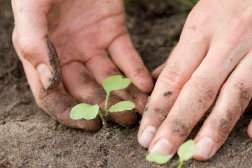By Urban Harvest

Even experienced gardeners and farmers do not utilize some essential and basic practices. These basics mark the difference between success and frustration. The following tips will make a difference for you.
The time to plant a specific vegetable, such as okra or squash, is keyed by the temperature required for that vegetable to germinate and be sustainable in the weather in which it pops from the soil.
Check the planting chart in Bob Randall's book "Year Round Vegetables, Fruits and Flowers for Metro Houston." In his book, he lists the best times to plant each vegetable and herb. This book is available at the Urban Harvest Farmers Markets at Eastside Street on Saturdays from 8 a.m. to noon, Urban Harvest’s gardening classes, as well as local nurseries such as Wabash Feedstore and Buchanan’s Native Plants.
In a new garden bed (new soil), use one cup of organic fertilizer per square foot prior to planting seeds. Sprinkle it on the surface, and work it in about an inch with a bow rake. On existing soils, use one cup of organic fertilizer per four square feet. Some vegetables, such as corn, are heavy feeders, requiring one cup of fertilizer per square foot of surface. Randall's book offers specific fertilizer needs for each vegetable type.
The depth a seed is planted depends on the size of the seed. The larger the seed, the deeper it is planted. Generally, plant seeds to a depth three times the width of the seed. For instance, a bush bean seed is planted about one inch deep, while a cucumber seed is planted about a quarter-inch to a half-inch deep.
Once planted, seeds need to be watered at least once a day. If the soil dries to the depth of the seed, the seed will dry and germination is less likely. Watering twice a day in hot weather is a good idea. Watering less than once a day likely will cause fewer seeds to germinate.
Spring is the time of year for beans, tomatoes and peppers, among many other plants. However, these three plants like to have dry leaves, so water the soil around the plant and do not get leaves wet. Wet leaves can lead to disease and loss of production. Use a long watering wand with a rose nozzle to make it easy to water the soil around the plant.
Once the weather gets hot, mulch about two inches deep around plants. Appropriate mulches are alfalfa hay (don’t use coastal hay because of prevalence of herbicides), native mulch (offered by Nature's Way Resources), or leaves that have been run over by a lawn mower to make them finer. Never use wood-based mulches, which pull nitrogen from the soil.
When planting seeds, space with the adult plant in mind so it has enough room without encroaching on neighboring plants. For instance, bush beans can be spaced on 8-inch squares, summer squash seeds planted one per 18-inch square, and cucumbers spaced every 12 inches along a trellis. If the plants are closer, there will be too much vegetation, not enough sun, and not enough air movement to keep leaves dry and free of disease.
It can be enjoyable and therapeutic to garden, but it sure is much more fun when your garden actually produces well. Your garden will be more productive if you keep these tips in mind.
This column is produced by Urban Harvest. Learn about gardening classes, community gardens and orchards, farmers markets and more at Urban Harvest’s website. The article is written by Ray Sher, a gardening and permaculture instructor with Urban Harvest, as well as a vegetable and fruit garden consultant. He is retired from farmer training of Congolese refugees with Plant It Forward Farms.